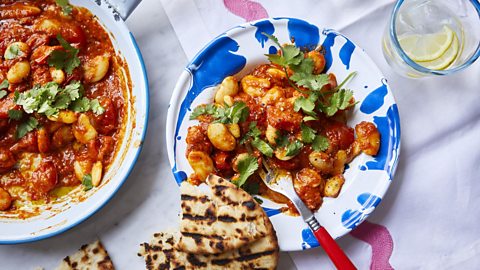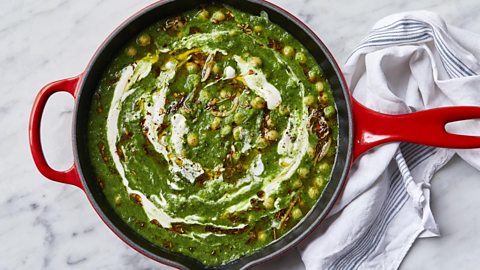The budget ingredient doctors would “probably prescribe”
Pulses, including beans, lentils and peas, are easy to cook, delicious and cheap. What’s more they’re incredibly good for you, says Dr Rupy Aujla.
At a time when food budgets are pushed, many of us are trying to find ways to keep costs down while still getting all the nutrients (and flavour) we need. Pulses are a great way to do this, says Aujla.
Curried butter beans with flatbreads
If you’re a fan of butter beans you’ll love this quick-to-prepare dish

What’s the difference between pulses and legumes?
Legumes are the plants, while pulses are the seeds or beans you’ll find in them. For a plant to be classified as a legume it must be part of the fabaceae family. Common pulses include kidney beans, butter beans, red lentils and chickpeas.
Creamy white beans with tahini, oregano and cumin
This recipe feels creamy and luxurious, highlighting just how versatile pulses can be to cook with

The health benefits of pulses
“Plant-based protein, lots of different types of fibre, very good for your gut health, [beans] are the kind of food we want to be focusing our [meals] around because they’re cheap and so nutritious,” explains Aujla.
Gochujang red beans with brown rice and kimchi
When cooking with pulses, if you have a few store cupboard staples such as pastes or dried spices you can quickly create dishes which use up leftover fridge ingredients

There’s also evidence eating beans and pulses regularly in the context of a Mediterranean diet may help prevent Type-2 diabetes in older adults at high cardiovascular risk. “If a drug had that kind of result, we’d probably prescribe it”, says Aujla.
When combined with grains in a meal, pulses can provide a ‘complete protein’, which means you get all nine essential amino acids (the building blocks of protein) your body needs. For example, wheat is low in the amino acid lysine, but beans are high in it, so you can serve them together for a complete protein, like in Aujla's wholegrain black bean stir-fry. Other pairings include beans on wholegrain toast and hummus with wholewheat pitta.
Pulses are also packed with fibre, a nutrient 90% of us lack. Insoluble fibre is believed to be beneficial for your gut microbiome, because bacteria in the gut ferments it. Soluble fibre has been shown to reduce elevated cholesterol levels and promote heart health.
Charred leek, fennel and haricot bean broth with dill and chilli oil
Leeks and fennel are wonderful sources of prebiotic fibres to support your gut and immune health, says Aujla

Pulses also contain vitamins and minerals, including copper, folate, iron, magnesium, manganese, phosphorous, potassium and zinc.
Cooking with pulses
Tinned pulses, including green lentils, chickpeas and kidney beans, require no cooking, so work well in speedy salads. Make Aujla’s quick beetroot hummus with a tin of chickpeas and eat with pitta chips or vegetable sticks.
Green pea chickpeas with spiced oil
Tinned chickpeas are so versatile and you can easily whip up a delicious dinner with the addition of a few frozen ingredients

Dried pulses tend to be cheaper than tinned. Dried red lentils only need boiling for around 20 minutes – try them in Aujla’s red lentil dal or mulligatawny soup.
Many dried beans and peas, such as chickpeas, black, pinto and kidney beans, need soaking for several hours before cooking and some need boiling for an hour until soft, but it’s easy to do. To get the same amount of beans as a 400g tin you will need about 120g/4¼oz dried beans. You can prepare more dried beans or peas than you need for a recipe and freeze the leftovers to use another time. Aujia uses dried pinto beans in his chipotle stew and dried kidney beans in smoky jambalaya.
Go to BBC Food for more of Aujla’s delicious bean, lentil and chickpea recipes.
Originally published July 2021, updated March 2024